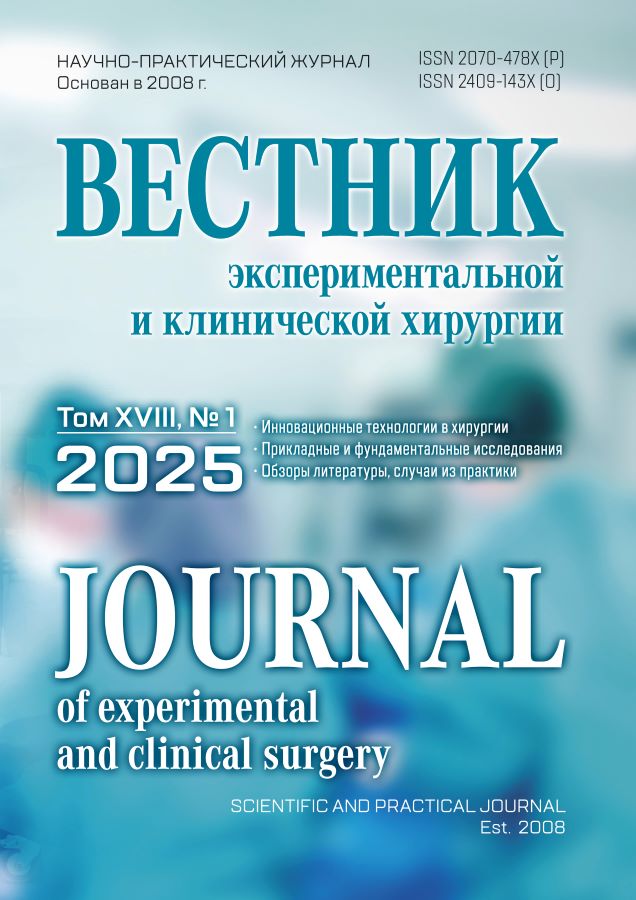Atrial fibrillation after coronary artery bypass grafting: analysed impact of coronary artery calcification
- Authors: Ganaev K.G.1, Akchurin R.S.1, Shiryaev A.A.1, Vlasova E.E.1, Vasiliev V.P.1, Galyautdinov D.M.1, Pashaev R.A.1
-
Affiliations:
- Chazov National Medical Research Center of Cardiology
- Issue: Vol 18, No 1 (2025)
- Pages: 19-26
- Section: Original articles
- URL: https://vestnik-surgery.com/journal/article/view/1794
- DOI: https://doi.org/10.18499/2070-478X-2025-18-1-19-26
- ID: 1794
Cite item
Abstract
Relevance. Atrial fibrillation (AF) is a significant problem in the postoperative period of coronary artery bypass grafting. The genesis of arrhythmia is not clear despite numerous studies. Identifying patients at high risk of postoperative AF remains a difficult and urgent task.
Aim. To evaluate the influence of coronary calcinosis and the corresponding surgical features of coronary artery bypass grafting on the occurrence of de novo atrial fibrillation in the postoperative period.
Materials and methods. The study included 35 patients with diffuse multivessel coronary disease, without a history of AF, aged 66±7 years; 77% were male patients. We preoperatively assessed the summed index of calcified lesions (SICL) and then its role in the occurrence of postoperative AF. There were two study groups: patients without AF (n=21) - no paroxysm of AF after CABG was registered - and patient with AF (n=14) - AF was detected in the postoperative period. We separately analysed patients’ findings in the subgroup of patients with SIBC> 12 points. Postoperative rhythm was assessed in the following way: daily ECG recording, continuous bedside ECG monitoring for up to 3 days, ECG Holter on the 4th-5th day after CABG. The median follow-up was 9 (7; 11) days.
Results. Having analyzed the frequency of postoperative AF in the group of patients with a diffuse type of lesion, and separately in the group of patients with a diffuse type of lesion and severe calcification, we detected the highest parameter in the latter - 40% vs 56%, respectively. Clinical, demographic and intraoperative parameters of CABG in the groups without AF and with AF were comparable. Echo parameters in the studied groups were also equivalent. It was found that the value of the summarized index of calcified coronary artery lesion more than 12 points determines the tendency for AF to occur in the postoperative period; OR = 3.60, 95% CI 0.870-14.904, p = 0.072.
Conclusions. Commonly accepted echo parameters (the left atrium size and volume) do not reflect the risks de novo of atrial fibrillation after coronary bypass surgery. The data of this study demonstrated that for patients with severe calcified coronary lesions, who underwent surgery using complex technical techniques, an increased frequency of postoperative AF is common in the postoperative period. Further studies are needed to assess the impact of the morphological type and severity of atherosclerotic lesions of the coronary arteries, as well as the corresponding technical features of coronary artery bypass grafting on the risk of AF after CABG; such an assessment will make a significant contribution to the potential prediction of the postoperative atrial fibrillation development.
Full Text
About the authors
Kamil G. Ganaev
Chazov National Medical Research Center of Cardiology
Author for correspondence.
Email: dr_ganaev@mail.ru
Ph.D., Department of cardiovascular surgery
Russian Federation, Moscow
Renat S. Akchurin
Chazov National Medical Research Center of Cardiology
Email: rsakchurin@list.ru
М.D., Acad. RAS, Professor, Chief of surgery
Russian Federation, MoscowAndrey A. Shiryaev
Chazov National Medical Research Center of Cardiology
Email: evsey101@mail.ru
М.D., Acad. RAS, Professor, Head of the Microsurgery Laboratory
Russian Federation, MoscowElina E. Vlasova
Chazov National Medical Research Center of Cardiology
Email: docelina@yandex.ru
Ph.D., Senior Researcher at the Microsurgery Department
Russian Federation, MoscowVladislav P. Vasiliev
Chazov National Medical Research Center of Cardiology
Email: vladpetrovich@mail.ru
Ph.D., Senior Researcher at the Microsurgery Department
Russian Federation, MoscowDamir M. Galyautdinov
Chazov National Medical Research Center of Cardiology
Email: damirmaga@mail.ru
Ph.D., Senior Researcher at the Microsurgery Department
Russian Federation, MoscowRasul A. Pashaev
Chazov National Medical Research Center of Cardiology
Email: rasul568@mail.ru
graduate student of cardiosurgery department
Russian Federation, MoscowReferences
- Filardo G, Damiano Jr, Ailawadi G, Thourani VH, Pollock BD, Sass DM, Phan TK, Nguyen H, Graca B. Epidemiology of new-onset AF following coronary artery bypass graft surgery. Heart. 2018;10:985-992. https://doi.org/10.1136/heartjnl-2017-312150
- Filardo G, Ailawadi G, Pollock B.D, Graca B, Sass DM, Phan TK, Montenegro DE, Thourani V, Damiano R. Sex differences in the epidemiology of new-onset in-hospital post-coronary artery bypass graft surgery AF: a large multicenter study. Circ Cardiovasc Qual Outcomes. 2016;9:723-730. https://doi.org/10.1161/CIRCOUTCOMES.116.003023
- Magne J, Salerno B, Mohty D, Serena C, Rolle F, Piccardo A, Echahidi N, Guyader A, Aboyans V. Echocardiography is useful to predict postoperative atrial fibrillation in patients undergoing isolated coronary bypass surgery: A prospective study. Eur Heart J Acute Cardiovasc Care. 2019;8(2):104-113. https://doi.org/10.1177/2048872616688419
- Moe G, Abildskov J, Atrial fibrillation as a self-sustaining arrhythmia independent of focal discharge. Am Heart J. 1959;58(1):59-70.
- Kourliouros A, Savelieva I, Kiotsekoglou A, Jahangiri M, Camm J. Current concepts in the pathogenesis of atrial fibrillation. Am Heart J. 2009;157(2):243-252. doi: 10.1016/j.ahj.2008.10.009
- Staerk L, Sherer JA, Ko D, Benjamin EJ, Helm RH. Atrial Fibrillation: Epidemiology, Pathophysiology, and Clinical Outcomes. Circ Res. 2017;120(9):1501-1517. doi: 10.1161/CIRCRESAHA.117.309732
- Cagli K, Gol MK, Keles T, Sener E, Yildiz U, Uncu H, Tasdemir O, Bayazit K. Risk factors associated with development of atrial fibrillation early after coronary artery bypass grafting. Am J Cardiol. 2000;85(10):1259-1261. doi: 10.1016/s0002-9149(00)00742-6.
- Banach M, Rysz J, Drozdz JA, Okonski P, Misztal M, Barylski M, Irzmanski R, Zaslonka J. Risk factors of atrial fibrillation following coronary artery bypass grafting: a preliminary report. Circ J. 2006; 70(4):438-41. doi: 10.1253/circj.70.438. PMID: 16565561.
- Creswell LL, Schuessler RB, Rosenbloom M, Cox JL. Hazards of postoperative atrial arrhythmias. Ann Thorac Surg. 1993;56(3):539-549. https://doi.org/10.1016/0003-4975(93)90894-N
- Fuller JA, Adams GG, Buxton B. Atrial fibrillation after coronary artery bypass grafting. Is it a disorder of the elderly? J Thorac Cardiovasc Surg. 1989;97(6):821-825.
- Maesen B, Nijs J, Maessen J, Allessie M, Schotten U. Post-operative atrial fibrillation: a maze of mechanisms. Europace. 2012;14(2):159-174. doi: 10.1093/europace/eur208
- Ho K, Tan J. Benefits and risks of corticosteroid prophylaxis in adult cardiac surgery: a dose-response meta-analysis. Circulation. 2009; 19(14): 1853-1866. doi: 10.1161/CIRCULATIONAHA.108.848218
- Ganaev KG, Vlasova EE, Avalyan AA, Saidova MA, Akchurin RS. The first experience of using speckle-tracking echocardiography technology in two-dimensional mode to assess the association of left atrial deformity with atrial fibrillation after coronary bypass surgery. Rossiiskii kardiologicheskii zhurnal. 2022;27(7):47-53. doi: 10.15829/1560-4071-2022-5026 (in Russ.)
- Ganaev KG, Vlasova EE, Shiryaev AA, Vasil'ev VP, Galyautdinov DM, Il'ina LN, Akchurin RS. Atrial fibrillation after coronary bypass surgery in patients with local and diffuse coronary artery disease. Kardiologicheskii vestnik. 2021;16(2):59–64. https://doi.org/10.17116/Cardiobulletin20211602159 (in Russ.)
- Belenkov YuN, Oganov RG. Kardiologiya. Natsional'noe rukovodstvo. Kratkoe izdanie. 2012; 848. (in Russ.)
- Kalman J, Munawar M, Howes L, Louis W, Buxton B, Gutteridge G, Tonkin A. Atrial fibrillation after coronary artery bypass grafting is associated with sympathetic activation. Ann Thorac Surg. 1995;60(6):1709-15. doi: 10.1016/0003-4975(95)00718-0.
- Akchurin RS, Salichkin DV, Emel'yanov AV, Galyautdinov DM, Vasil'ev VP, Shiryaev AA. Coronary bypass surgery for diffuse and distal lesions of the coronary arteries. Kardiologicheskii vestnik. 2015; 4: 50-55. (in Russ.)
- White H, Antman E, Glynn M, Collins J, Cohn L, Shemin R, Friedman P. Efficacy and safety of timolol for prevention of supraventricular tachyarrhythmias after coronary artery bypass surgery. Circulation. 1984 Sep;70(3):479-484. doi: 10.1161/01.cir.70.3.479.
- Moulton M, Creswell L, Mackey M, Cox J, Rosenbloom M. Reexploration for bleeding is a risk factor for adverse outcomes after cardiac operations. J Thorac Cardiovasc Surg. 1996;111(5):1037-1046. doi: 10.1016/s0022-5223(96)70380-x
- Creswell LL, Schuessler RB, Rosenbloom M, Cox JL. Hazards of postoperative atrial arrhythmias. Ann Thorac Surg. 1993; 56(3):539-549. https://doi.org/10.1016/0003-4975(93)90894-n
- Goldman L. Supraventricular tachyarrhythmias in hospitalized adults after surgery. Clinical correlates in patients over 40 years of age after major noncardiac surgery. Chest. 1978;73(4):450-454.
Supplementary files


















